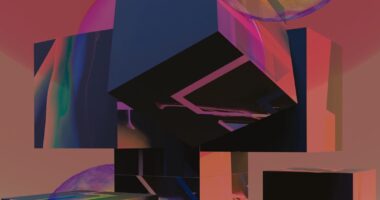Non-fungible tokens (NFTs) are unique digital assets that represent ownership or proof of authenticity of specific items or content, such as artwork, videos, music, or tweets. Unlike fungible cryptocurrencies like Bitcoin or Ethereum, NFTs cannot be exchanged on a one-to-one basis due to their individual uniqueness. NFTs utilize blockchain technology, a decentralized and distributed digital ledger that records transactions across multiple computers.
This technology ensures each NFT’s uniqueness and prevents replication. When an NFT is purchased, ownership and transaction details are recorded on the blockchain, providing a transparent and immutable ownership record. Blockchain technology gives creators and collectors confidence in the authenticity and scarcity of their digital assets.
NFTs can be bought, sold, and traded on various online marketplaces, enabling creators to monetize their digital content through new channels. In essence, NFTs are distinct digital assets representing ownership or authenticity of specific items or content. Built on blockchain technology, they ensure uniqueness and provide transparent ownership records.
NFTs can be traded on online platforms, offering creators innovative ways to monetize their digital work.
Key Takeaways
- NFTs are unique digital assets that represent ownership of a specific item or piece of content on the blockchain.
- When choosing an NFT platform for your project, consider factors such as fees, user base, and the platform’s reputation for security and authenticity.
- Creating and minting NFTs involves uploading your digital content to a platform, setting parameters for the NFT, and paying a minting fee.
- Marketing and promoting your NFT project requires building a strong online presence, engaging with the NFT community, and leveraging social media and other digital marketing channels.
- Legal and copyright considerations for NFTs include understanding intellectual property rights, licensing agreements, and potential disputes over ownership and authenticity.
Choosing the Right NFT Platform for Your Project
Popular NFT Platforms
One of the most popular NFT platforms is OpenSea, which allows users to create, buy, and sell NFTs across a wide range of categories, including art, domain names, and virtual worlds. OpenSea is known for its user-friendly interface and low fees, making it an attractive option for both creators and collectors. Another popular platform is Rarible, which offers customizable NFT creation tools and a decentralized marketplace for buying and selling digital assets.
Key Features to Consider
Rarible also allows creators to earn royalties on secondary sales of their NFTs, providing a source of ongoing income. In addition to these platforms, there are niche marketplaces catering to specific types of content, such as music (Audius), virtual real estate (Decentraland), and collectible trading cards (NBA Top Shot). It’s important to consider the specific needs and preferences of your target audience when choosing a platform for your NFT project.
Choosing the Right Platform for Your Project
By carefully evaluating the features, fees, and policies of different platforms, you can select the one that best aligns with your project’s goals and values. This will help ensure the success of your NFT project and provide a positive experience for your target audience.
Creating and Minting Your NFTs: A Step-by-Step Guide

Once you’ve chosen the right platform for your NFT project, the next step is to create and mint your NFTs. Minting an NFT involves uploading your digital content to the blockchain and creating a unique token that represents ownership or proof of authenticity. Most NFT platforms provide tools and resources to guide you through the minting process, making it accessible to creators with varying levels of technical expertise.
To create an NFT, you’ll need to prepare your digital content, such as artwork, videos, or music, in a compatible file format. You’ll then upload this content to the platform’s marketplace or minting interface, where you can add details such as title, description, and edition size. Once your content is uploaded, the platform will generate a unique token on the blockchain that represents your NFT.
This token will include metadata that describes the characteristics and provenance of your digital asset, ensuring its authenticity and uniqueness. After minting your NFTs, you can list them for sale on the platform’s marketplace or share them with your audience through social media and other channels. It’s important to promote your NFTs effectively to attract potential buyers and collectors.
By following these steps and leveraging the resources provided by your chosen platform, you can successfully create and mint your NFTs to share with the world.
Marketing and Promoting Your NFT Project
Marketing and promoting your NFT project is essential for attracting buyers and collectors to your digital assets. There are several strategies you can use to increase visibility and generate interest in your NFTs, including leveraging social media, collaborating with influencers, and participating in online communities. Social media platforms such as Twitter, Instagram, and TikTok are powerful tools for promoting your NFT project and connecting with potential buyers.
You can share behind-the-scenes content, previews of upcoming releases, and engaging stories to build excitement and anticipation around your digital assets. Engaging with your audience through comments, likes, and direct messages can help foster a sense of community and loyalty among your followers. Collaborating with influencers and creators in your niche can also help expand your reach and attract new collectors to your NFT project.
By partnering with individuals who have a strong following and influence in your target audience, you can leverage their credibility and reach to promote your digital assets to a wider audience. Participating in online communities such as Discord servers, forums, and virtual events can also help you connect with like-minded individuals who are interested in NFTs and digital collectibles. Engaging in conversations, sharing your work, and seeking feedback from the community can help you build relationships and gain valuable insights into the preferences and interests of potential buyers.
By implementing these marketing strategies and staying active and engaged with your audience, you can effectively promote your NFT project and attract collectors to your digital assets.
Legal and Copyright Considerations for NFTs
As with any creative endeavor, it’s important to consider legal and copyright implications when creating and selling NFTs. Copyright law protects original works of authorship fixed in a tangible medium of expression, including visual art, music, literature, and other creative content. When minting an NFT based on copyrighted material, it’s crucial to ensure that you have the legal right to do so.
If you’re a creator looking to sell original artwork or content as an NFT, it’s important to understand the terms of use of the platform you’re using and any potential implications for copyright ownership. Some platforms may require creators to grant certain rights or licenses when minting an NFT, so it’s important to review the terms carefully before proceeding. For collectors purchasing NFTs, it’s important to verify the authenticity and provenance of the digital assets they’re acquiring.
Due diligence should be conducted to ensure that the seller has the legal right to sell the NFT and that it does not infringe on any existing copyrights or intellectual property rights. In summary, legal and copyright considerations are important aspects of creating and selling NFTs. Creators should ensure they have the legal right to mint NFTs based on copyrighted material, while collectors should conduct due diligence to verify the authenticity and legality of the digital assets they’re acquiring.
Building a Team: Essential NFT Jobs and Roles

Launching a successful NFT project often requires collaboration with a diverse team of professionals who can contribute their expertise in various areas. From artists and developers to marketers and legal advisors, there are several essential roles that play a crucial part in bringing an NFT project to life. Artists are at the core of many NFT projects, creating original artwork or digital content that forms the basis of the digital assets being minted as NFTs.
Their creativity and vision are essential for producing compelling and unique content that resonates with collectors. Developers play a key role in implementing blockchain technology and smart contracts to create and mint NFTs on various platforms. Their technical expertise is crucial for ensuring that the minting process is secure, efficient, and user-friendly.
Marketers are responsible for promoting NFT projects and attracting collectors to the digital assets being offered for sale. Their skills in branding, social media management, influencer partnerships, and community engagement are essential for building awareness and generating interest in the project. Legal advisors provide guidance on copyright law, intellectual property rights, terms of use for NFT platforms, and other legal considerations related to creating and selling digital assets as NFTs.
Their expertise is crucial for ensuring compliance with relevant laws and regulations. By assembling a team with diverse skills and expertise in these areas, creators can maximize their chances of success in launching an NFT project that resonates with collectors and stands out in the competitive marketplace.
Navigating the Future of NFTs: Trends and Opportunities
As the popularity of NFTs continues to grow, there are several trends and opportunities shaping the future of this emerging industry. From virtual real estate to gaming collectibles to digital fashion, there are countless possibilities for creators to explore new frontiers in the world of non-fungible tokens. Virtual real estate is an exciting area of opportunity within the NFT space, with platforms such as Decentraland offering users the ability to buy, sell, and develop virtual land using blockchain technology.
This opens up new possibilities for immersive experiences, social interactions, and creative expression within virtual worlds. Gaming collectibles are another promising area within the NFT space, with platforms like NBA Top Shot enabling fans to collect and trade officially licensed digital basketball highlights as non-fungible tokens. This intersection of sports fandom, gaming culture, and blockchain technology presents new opportunities for engaging with audiences in innovative ways.
Digital fashion is also emerging as a trend within the NFT space, with designers creating virtual clothing and accessories that can be bought as non-fungible tokens and worn within virtual environments or shared on social media. This blurring of boundaries between physical fashion and digital expression opens up new possibilities for self-expression and creativity. In conclusion, the future of NFTs is filled with exciting trends and opportunities across various industries.
From virtual real estate to gaming collectibles to digital fashion, there are countless possibilities for creators to explore new frontiers in the world of non-fungible tokens. By staying informed about these trends and embracing new opportunities as they arise, creators can position themselves for success in this rapidly evolving industry.
If you’re interested in learning more about the potential job opportunities in the NFT space, check out this article on NFT Jobs. It provides valuable insights into the various roles and skills needed to thrive in the NFT industry, making it a great complement to the beginner’s guide on starting an NFT project.
FAQs
What is an NFT project?
An NFT project refers to a digital initiative that involves creating and selling non-fungible tokens (NFTs). These tokens are unique digital assets that are stored on a blockchain and can represent ownership of digital or physical items such as art, music, videos, and more.
How do I start an NFT project?
To start an NFT project, you will need to familiarize yourself with blockchain technology, choose a suitable blockchain platform for creating and selling NFTs, create digital assets to be tokenized, and then mint those assets into NFTs using a platform that supports NFT creation.
What are the steps involved in starting an NFT project?
The steps involved in starting an NFT project include researching and understanding the NFT market, choosing a blockchain platform, creating digital assets, minting NFTs, setting up a marketplace for selling NFTs, and promoting your NFT project to potential buyers.
What are some popular blockchain platforms for creating NFTs?
Some popular blockchain platforms for creating NFTs include Ethereum, Binance Smart Chain, Flow by Dapper Labs, Tezos, and Polkadot. Each platform has its own unique features and benefits for creating and selling NFTs.
What are some considerations for creating digital assets for an NFT project?
When creating digital assets for an NFT project, it’s important to consider the uniqueness, scarcity, and desirability of the assets. High-quality and original digital content such as artwork, music, videos, and collectibles tend to perform well in the NFT market.
How can I promote my NFT project to potential buyers?
You can promote your NFT project to potential buyers through social media marketing, influencer partnerships, participating in NFT marketplaces and auctions, creating a website or blog to showcase your NFTs, and engaging with the NFT community through forums and events.





